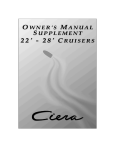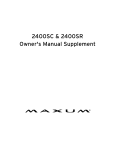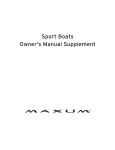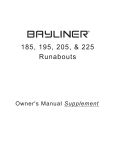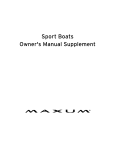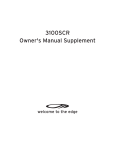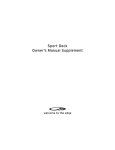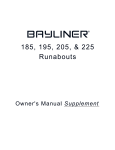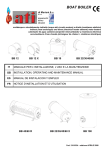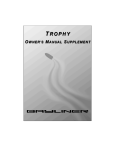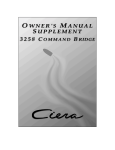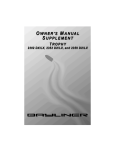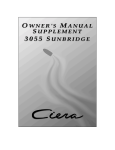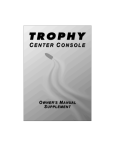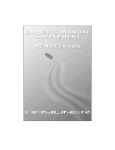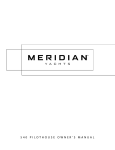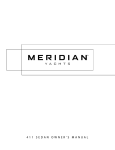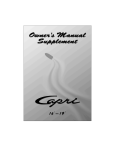Download Maxum 1750SR Specifications
Transcript
Engine Serial Number: _____________________________________________ Hull Identification Number:__________________________________________ Hull Identification Number The Hull Identification Number (HIN) is located on the starboard side of the transom. Be sure to record the HIN (and the engine serial numbers) in the space provided above. Please refer to the HIN for any correspondence or orders. HIN LOCATION © 2002 Maxum Marine Technical Publications. All rights reserved. No part of this publication may be reproduced, stored in any retrieval system, or transmitted in any form by any means, electronic, mechanical, photocopying, recording or otherwise, without prior written permission of Maxum. Printed in the U.S.A. General Notes The material in this document is for information only and is subject to change without notice. While reasonable efforts have been made in the preparation of this document to assure its accuracy, Maxum assumes no liability resulting from errors or omissions in this document, or from the use of information contained herein. Due to our commitment to product improvement, Maxum reserves the right to make changes in the product design, specifications and equipment at any time without notice or obligation. Illustrations and/or photos may show optional equipment. All Maxum products meet or exceed USCG (Unites States Coast Guard) and/or NMMA (National Marine Manufacturer’s Association) construction standards. Manufactured with 1,1,1 Trichloroethane, a substance which harms public health and environment during the manufacturing process by destroying ozone in the upper atmosphere. Proprietary Rights This document discloses subject matter in which Maxum has proprietary rights. The information and design disclosed herein were originated by and are the property of Maxum. Neither receipt nor possession thereof confers or transfers any right to reproduce, copy, alter or disclose the document or any part thereof, any information contained therein, or to construct boats or any item from it, except by written permission from or written agreement with Maxum. This document is to be returned upon request to Maxum. CONTENTS Chapter 1: Welcome Aboard! Chapter 4: Propulsion & Related Systems 1 Dealer Service 17 Engine 1 About Your Limited Warranty 17 Engine Room Ventilation System 1 Boating Experience 18 Fuel System 2 Safety Standards 2 Engine & Accessories Guidelines 2 Engine & Accessories Literature 3 Qualified Maintenance 3 Special Care For Moored Boats Chapter 5: Controls 4 Carbon Monoxide (CO) 21 Steering 4 5 21 Shift/Throttle 21 Power Trim and Tilt 5 Sources of CO What if Carbon Monoxide is Detected or Suspected? Carbon Monoxide Alarm System (2100SC Only) Chapter 2: Product Specifications 18 Fuel Fill and Vent 18 Fuel Filters 18 Anti-siphon Valve 20 Quick Oil Drain System Chapter 6: Navigation & Communication Equipment 22 Depth Finder (If Equipped) 6 1750SR 7 1800SR Chapter 7: Plumbing 8 1900SR 23 9 2100SR 10 2100SC Bilge Pump 25 Autofloat Switch (If Equipped) 25 Drain Systems (2100SC Only) 25 Deck Drains Chapter 3: Locations 11 Exterior Views 11 12 13 14 15 16 Hull Views 1750SR Deck Views 1800SR Deck Views 1900SR & 2100SR Deck Views 2100SC Deck Views Component Locations 26 Portable Toilet (2100SC Only, If Equipped)) 27 Portable Head Pump-Out (2100SC Only, If Equipped) Chapter 8: Deck Equipment Chapter 11: Lights 28 Cleats and Tow Eyes 37 Care and Maintenance 28 Ski Tow Ring 37 Navigation Lights 29 Canvas 29 29 30 31 Canvas Top (If Equipped) Installing the Canvas 1750SR & 1800SR Bimini Top (If Equipped) 1900SR, 2100SR & 2100SC Bimini Top (If Equipped) Chapter 12: Electrical System 39 39 39 39 39 39 Chapter 9: Entertainment Systems 32 Audio & Visual Equipment 40 Sleeper Seats (If Equipped) 33 Operating Positions 33 Lounge positions 34 Cuddy Cabin to V-Berth Conversion (2100SC Only) 36 Jump Seat To Sunlounge Conversion (If Equipped) 46 Battery Fuses and Circuit Breakers Alternator 12-Volt Accessory Outlet Battery Switch (If Equipped) Electrical Routings 40 41 42 43 44 44 45 Chapter 10: Convertible Seats, Beds, & Tables 33 12-Volt DC System 1750SR Deck Electrical Harness 1800SR Deck Electrical Harness 1900SR & 2100SR Deck Electrical Harness 2100SC Deck Electrical Harness 1750SR Hull Electrical Harness 1800SR Hull Electrical Harness 1900SR, 2100SR & 2100SC Hull Electrical Harness Wiring Diagrams 46 1750SR & 1800SR 47 1900SR, 2100SR & 2100SC Hazard Boxes & Symbols The hazard boxes and symbols shown below are used throughout this supplement to call attention to potentially dangerous situations which could lead to either personal injury or product damage. Read ALL warnings carefully and follow all safety instructions. DANGER! ! This box alerts you to immediate hazards which WILL cause severe personal injury or death if the warning is ignored. ! WARNING! This box alerts you to hazards or unsafe practices which COULD result in severe personal injury or death if the warning is ignored. ! CAUTI ON! This box alerts you to hazards or unsafe practices which COULD result in minor personal injury or cause product or property damage if the warning is ignored. NOTICE This box calls attention to installation, operation or maintenance information, which is important to proper operation but is not hazard related. FIRE HAZARD! EXPLOSION HAZARD! CO POISONING HAZARD! ELECTRICAL HAZARD! FALLING HAZARD! NO OPEN FLAME! HOT HAZARD! ROTATING PROPELLER HAZARD! RUN BILGE BLOWERS FOR 4 MINUTES! 1 Chapter 1: Welcome Aboard! This Owner’s Manual Supplement provides specific information about your boat that is not covered in the Sport Boat Owner’s Manual. Please study the Sport Boat Owner’s Manual and this supplement carefully. Keep the Sport Boat Owner’s Manual and this supplement on your boat in a secure, yet readily available place. Dealer Service • • • • • Ask your dealer to explain all systems before taking delivery of your boat. Your dealer is your key to service. Contact your dealer if you have any problems with your new boat. If your dealer cannot help, call our customer service hotline: 360-435-8957 or send us a FAX: 360-403-4235. Buy replacement parts from any authorized Maxum dealer. About Your Limited Warranty • Maxum offers a Limited Warranty on each new Maxum purchased through an authorized Maxum dealer. • A copy of the Limited Warranty was included in your owner’s packet. • If you did not receive a copy of the Limited Warranty, please contact your dealer or call 360-435-8957 for a copy. Boating Experience ! WARNING! CONTROL HAZARD! A qualified operator must be in control of the boat at all times. DO NOT operate your boat while under the influence of alcohol or drugs. If this is your first boat or if you are changing to a type of boat you are not familiar with, for your own comfort and safety, obtain handling and operating experience before assuming command of the boat. Take one of the boating safety classes offered by the U.S. Power Squadrons or the U.S. Coast Guard Auxiliary. For more course information, including dates and locations of upcoming classes, contact the organizations directly: • U.S. Power Squadrons: 1-888-FOR-USPS (1-888-367-8777) or on the Internet at: http://www.usps.org • U.S. Coast Guard Auxiliary: 1-800-368-5647 or on the Internet at: http://www.cgaux.org Outside the United States, your selling dealer, national sailing federation or local boat club can advise you of local sea schools or competent instructors. 2 CHAPTER 1: WELCOME ABOARD! Safety Standards DANGER! DANGER ! PERSONAL SAFETY HAZARD! DO NOT allow anyone to ride on parts of the boat not designated for such use. Sitting on seat backs, lounging on the forward deck, bow riding, gunwale riding or occupying the transom platform while underway is especially hazardous and will cause personal injury or death. DANGER! DANGER ! PERSONAL SAFETY HAZARD! ALWAYS secure the anchor and other loose objects before getting underway. The anchor and other items that are not properly secured can come loose when the boat is moving and cause personal injury or death. • Your boat’s mechanical and electrical systems were designed to meet safety standards in effect at the time it was built. • Some of these standards were mandated by law, all of them were designed to insure your safety, and the safety of other people, vessels and property. In addition to this Owner’s Manual Supplement, please read the Sport Boat Owner’s Manual and all accessory instructions for important safety standards and hazard information. Engine & Accessories Guidelines NOTICE When storing your boat please refer to your engine’s operation and maintenance manuals. • Your boat’s engine and accessories were selected to provide optimum performance and service. • Installing a different engine or other accessories may cause unwanted handling characteristics. • Should you choose to install a different engine or to add accessories that will affect the boat’s running trim, have an experienced marine technician perform a safety inspection and handling test before operating your boat again. Certain modifications to your boat can result in cancellation of your warranty protection. Always check with your dealer before making any modifications to your boat. Engine & Accessories Literature • The engine and accessories installed on your boat come with their own operation and maintenance manuals. • Read and understand these manuals before using the engine and accessories. • Unless noted otherwise, all engine and accessory literature referred to in this supplement is included in your owner’s packet. CHAPTER 1: WELCOME ABOARD! 3 Qualified Maintenance ! WARNING! To maintain the integrity and safety of your boat, allow only qualified personnel to perform maintenance on, or in any way modify: The steering system, propulsion system, engine control system, fuel system, environmental control system, electrical system or navigational system. • Failure to maintain your boat’s systems (listed in the warning above) as designed could violate the laws in your jurisdiction and could expose you and other people to the danger of bodily injury or accidental death. • Follow the instructions provided in the Sport Boat Owner’s Manual, this Owner’s Manual Supplement, the engine owner’s manual and all accessory instruction sheets and manuals. Special Care For Moored Boats NOTICE • To help seal the hull bottom and reduce the possibility of gelcoat blistering on moored boats, apply an epoxy barrier coating, such as INTERLUX, Interprotect 2000E/2001E. The barrier coating should be covered with several coats of anti-fouling paint. • Many states regulate the chemical content of bottom paints in order to meet environmental standards. Check with your local dealer about recommended bottom paints, and about the laws in effect in your area. • Whether moored in saltwater or freshwater, your boat will collect marine growth on its hull bottom. • This will detract from the boat’s beauty, greatly affect its performance and may damage the gelcoat. • Periodically haul the boat out of the water and scrub the hull bottom with a bristle brush and a solution of soap and water. 4 CHAPTER 1: WELCOME ABOARD! Carbon Monoxide (CO) ! DANGER! CARBON MONOXIDE POISONING HAZARD! DANGER Carbon monoxide gas (CO) is colorless, odorless, and extremely dangerous. All engines, generators, and fuel burning appliances produce CO as exhaust. Direct and prolonged exposure to CO will cause BRAIN DAMAGE or DEATH. Signs of CO poisoning include: • Headache • Nausea • Dizziness • Drowsiness • • • • CO poisoning causes a significant number of boating deaths each year. Called the "silent killer", CO is an extremely toxic, colorless, odorless and tasteless gas. Breathing CO blocks the ability of your blood to carry oxygen. The effects are cumulative, even low levels of exposure can result in injury or death. Factors increasing the effects of CO poisoning include: • Age • Smokers or people exposed to high concentrations of cigarette smoke • Consumption of alcohol • Lung disorders • Heart problems • Pregnancy Sources of CO To correct stationary situations a and/or b: • Close all windows, portlights and hatches. • If possible, move your boat away from source of CO. To correct running situations c and/or d: • Trim bow down. • Open windows and canvas. • When possible, run boat so that prevailing winds help dissipate exhaust. Sources of CO include: a. Using engine, generator, or other fuel burning device when boat is moored in a confined space. b. Mooring too close to another boat that is using its engine, generator, or other fuel burning device. c. Running boat with trim angle of bow too high. d. Running boat without through ventilation (station wagon effect). IMMEDIATELY take corrective action if CO is detected or suspected. CHAPTER 1: WELCOME ABOARD! 5 What if Carbon Monoxide is Detected or Suspected? • Immediately ventilate and evacuate any enclosed spaces that are occupied by people and reset your CO alarm. • Immediately move anyone showing any symptoms of CO poisoning into fresh air. • See a doctor if any symptoms persist. If the person is unconscious, immediately administer oxygen or CPR and call for emergency help. Carbon Monoxide Alarm System (2100SC Only) • Your boat may feature a carbon monoxide (CO) alarm system. • Do not disconnect the alarm system. • Read and understand the manufacturer’s instructions for your CO alarm system. If you did not receive an instruction manual, call (800) 383-0269 and one will be mailed to you. • If your boat is not equipped with a carbon monoxide alarm, consider purchasing one from your dealer or marine supply store. 6 Chapter 2: Product Specifications 1750SR Overall Bridge Draft Draft (Drive Length Clearance Beam (Drive Up) Down) 17' 8" 3' 8" 7' 1" 1' 6" 2' 11" Fuel Capacity (gal.) 21 CHAPTER 2: PRODUCT SPECIFICATIONS 1800SR STANDARD SEATING SPORT SEATING Overall Bridge Draft Draft (Drive Length Clearance Beam (Drive Up) Down) 18' 1" 3' 6" 7' 6" 1' 6" 2' 8" Fuel Capacity (gal.) 30 7 8 CHAPTER 2: PRODUCT SPECIFICATIONS 1900SR STANDARD SEATING SPORT SEATING Overall Bridge Draft Draft (Drive Beam Length Clearance (Drive Up) Down) 19' 0" 4' 2" 8' 0" 1' 7" 2' 10" Fuel Capacity (gal.) 35 CHAPTER 2: PRODUCT SPECIFICATIONS 2100SR STANDARD SEATING SPORT SEATING Overall Bridge Draft Draft (Drive Beam Length Clearance (Drive Up) Down) 21' 2" 3' 11" 8' 6" 1' 4" 2' 8" Fuel Capacity (gal.) 50 9 10 CHAPTER 2: PRODUCT SPECIFICATIONS 2100SC STANDARD SEATING SPORT SEATING Overall Bridge Draft Draft (Drive Beam Length Clearance (Drive Up) Down) 21' 6" 4' 10" 8' 6" 1' 5" 2' 9" Fuel Capacity (gal.) 50 11 Chapter 3: Locations Exterior Views Hull Views WASTE TANK VENT (2100SC ONLY) BILGE PUMP DRAIN STARBOARD HULLSIDE ANCHOR LOCKER DRAIN (2100SC ONLY) BOW EYE DASH DRAIN PORT HULLSIDE TRANSOM STERN EYE STERN EYE GARBOARD DRAIN PLUG 12 CHAPTER 3: LOCATIONS 1750SR Deck View s CUP HOLDER CLEAT GRAB HANDLE CUP HOLDER BOW LIGHT HORN CLEAT CUP HOLDERS GRAB HANDLES SPEAKER CLEAT ALL AROUND LIGHT SOCKET GRAB HANDLE CLEAT BOARDING LADDER FUEL FILL FUEL VENT SKI TOW CHAPTER 3: LOCATIONS 1800SR Deck View s CLEAT GRAB HANDLE CLEAT BOW LIGHT CUP HOLDERS CLEAT CLEAT HORN GRAB HANDLE GRAB HANDLE BLOWER VENTS CLEAT BLOWER VENTS CLEAT ALL AROUND LIGHT SOCKET FUEL VENT SKI TOW BOARDING LADDER GRAB HANDLE FUEL FILL 13 14 CHAPTER 3: LOCATIONS 1900SR & 2100SR Deck Vie ws CUP HOLDER CLEAT GRAB HANDLE CLEAT BOW LIGHT CLEAT CUP HOLDER CLEAT HORN GRAB HANDLE CLEAT BLOWER VENTS BLOWER VENTS ALL AROUND LIGHT SOCKET CLEAT SKI TOW FUEL FILL FUEL VENT BOARDING LADDER GRAB HANDLE CHAPTER 3: LOCATIONS 2100SC Deck View s GRAB RAILS CLEAT CLEAT PORT BOW LIGHT ANCHOR LOCKER BOW HATCH CLEAT STARBOARD BOW LIGHT HORN CLEAT CLEAT BOW ROLLER BLOWER VENTS BLOWER VENTS CLEAT ALL AROUND LIGHT SOCKET SKI TOW GRAB RAIL BOARDING LADDER FUEL FILL FUEL VENT 15 16 CHAPTER 3: LOCATIONS Component Locations 12-Volt Accessory Outlet: At the helm, on the dash panel. Battery: • All models except the 1750SR: On the port side of the engine compartment. • 1750SR: On the starboard side of the engine compartment. Battery Switch (If Equipped): Access is through the hatch behind the port jump seat. Bilge pump: In the engine compartment. Carbon Monoxide Detector (2100SC Only): In the V-berth, on the starboard aft wall. Depth Sounder Transducer (If Equipped): In the engine compartment. Engine Circuit Breaker: On the engine. Fuel Fill Deck Fitting: • All models except the 1750SR: On the starboard aft corner of the deck. • 1750SR: On the port aft corner of the deck. Fuel Tank: In the engine compartment, forward of the engine. Navigation Lights: Red and green bow lights on the forward deck. White all-around light on the stern. 17 Chapter 4: Propulsion & Related System s Engine Read and understand the engine operation and maintenance manuals before starting or doing any maintenance on the engine. Engine Room Ventilation System ! • • • • WARNING! FIRE/EXPLOSION HAZARD Use of the blower system is NOT A GUARANTEE that explosive fumes have been removed. If you smell fuel, DO NOT start the engine and DO NOT turn on any electrical devices. If you smell fuel and the engine is already running, SHUT OFF the engine and TURN OFF all electrical devices. Investigate immediately. DO NOT obstruct or modify the ventilation system. • The bilge blower removes explosive fuel fumes from the engine compartment. • Fresh air is drawn into the compartment through the deck vents. • The blower switch is at the helm. To make sure the engine compartment is ventilated with fresh air, run the bilge blower: • For at least four minutes before starting the engine. • During starting. • Anytime your boat is running below cruising speed. BILGE BLOWER SYSTEM VENTILATION HOSES BILGE BLOWER 18 CHAPTER 4: PROPULSION & RELATED SYSTEMS Fuel System ! WARNING! FIRE, EXPLOSION AND OPEN FLAME HAZARD! • It is very important that the fuel system be inspected thoroughly the first time it is filled and at each subsequent filling. • The fueling instructions in the Cruiser & Yacht Owner’s Manual and the fuel recommendations in the engine operation manual must be followed. ! CAUTION Avoid the storage or handling of gear near the fuel lines, fittings and tank. Fuel Fill and Vent • The fuel fill fitting is marked “GAS”. • The fuel tank vent is located below the fuel fill. • If you experience difficulty filling the fuel tank, check to see that the fuel fill hose and vent hose are free of obstructions and kinks. Fuel Filters • The fuel pickup tube (located inside the fuel tank) is equipped with a fine mesh screen filter. • In addition, when supplied by the engine manufacturer, a fuel filter is installed on the engine. • Periodically replace the fuel filters to make sure they remain clean and free of debris. • Consult with your selling dealer or local marina concerning fuel additives that help to prevent fungus or other buildup in your fuel tank. Anti-siphon Valve NOTICE • If an engine running problem is diagnosed as fuel starvation, check the anti-siphon valve. If the valve is stuck or clogged, change or replace it while the engine is shut down. • NEVER run the engine with the anti-siphon valve removed, except in an emergency. • • • • The fuel system is equipped with an anti-siphon valve. The valve is located at the point where the fuel feed line attaches to the fuel tank. The valve is spring loaded and is opened by fuel pump vacuum. This valve will prevent fuel from siphoning from the tank in the event of a fuel line rupture. CHAPTER 4: PROPULSION & RELATED SYSTEMS 1750SR Fuel System Routing FUEL TANK FUEL FILL HOSE THRU-HULL FUEL LINE FUEL TANK VENT HOSE 1800SR, 1900SR, 2100SR, & 2100SC Fuel System Routing FUEL FILL HOSE FUEL TANK VENT HOSE FUEL TANK FUEL LINE 19 20 CHAPTER 4: PROPULSION & RELATED SYSTEMS Quick Oil Drain System QUICK OIL DRAIN SYSTEM TRANSOM OIL DRAIN HOSE OIL DRAIN PLUG ENGINE OIL PAN GARBOARD DRAIN PLUG DRAW CORD BILGE GARBOARD DRAIN To drain the engine oil: 1. 2. 3. 4. 5. 6. 7. 8. Remove the boat from the water. Unscrew the garboard drain plug. Pull the draw cord until the oil drain plug and the oil drain hose slide out of the garboard drain. Place the end of the oil drain hose into a suitable container. Unscrew the oil drain plug and drain the engine oil. Replace the oil drain plug. Push the drain hose back into the bilge. Replace the garboard drain plug. Always dispose of waste oil in accordance with local regulations. 21 Chapter 5: Controls Steering • This boat features a power assisted rack-and-pinion steering system. • Check the fluid level in the power steering reservoir every time you use your boat. • Boat steering is not self-centering. Shift/Throttle ! WARNING! LOSS OF CONTROL HAZARD! Improper maintenance of shift/throttle hardware may cause a sudden loss of control! • Carefully read and understand all of the information about the shift/throttle in the Sport Boat Owner’s Manual. • Also, read and understand the shifter/throttle and engine manuals. Power Trim and Tilt • The stern drive on your boat is equipped with power trim and tilt. • Trim and tilt instructions are provided in the engine operation manual and the shifter/throttle manual. 22 Chapter 6: Navigation & Communication Equipmen t Thoroughly read and understand the navigation and communication manuals before using these systems for the first time and observe the following: Depth Finder (If Equipped) ! WARNING! • DO NOT use the depth finder as a navigational aid to prevent collision, grounding, boat damage or personal injury. • When the boat is moving, submerged objects will not be seen until they are already under the boat. • Bottom depths may change too quickly to allow time for the boat to react. • If you suspect shallow water or submerged objects, run the boat at very slow speeds. 23 Chapter 7: Plumbing Bilge Pump NOTICE Discharge of oil, oil waste or fuel into navigable waters is prohibited by law. Violators are subject to legal action by the local authorities. • Your boat is equipped with a bilge pump for pumping water out of the bilge. • The bilge pump is controlled by an automatic bilge pump float switch (autofloat switch) and/or a switch at the helm. THRU-HULL BILGE PUMP & FLOAT SWITCH 24 CHAPTER 7: PLUMBING Bilge Pump Testing • The bilge pump is critical to the safety of your boat. • As follows, test the bilge pump often to make sure it is working. 1. 2. • • Turn on the bilge pump switch at the helm. Any water in the bilge should pump overboard. If the pump motor is running but not pumping, inspect the discharge hose for a kink or collapsed area. If no problems are found, check the bilge pump housing for clogging debris as follows: 1. Remove the power cartridge: BILGE PUMP COMPONENTS a. Lift the tab while rotating the fins counter-clockwise. OUTER LIGHT FILM OF OIL HOUSING “O” RING b. Lift out the power cartridge. c. Clear the outer housing of debris. 2. Reinstall the power cartridge: a. Make sure the “O” ring is properly seated. b. Coat the “O” ring with a light film of vegetable or mineral oil. c. Align the cams on either side of the power cartridge with TAB FIN CAM POWER SLOT (TYPICAL) CARTRIDGE (TYPICAL) the two slots on the outer housing. d. Press the power cartridge into the housing while twisting clockwise. 3. Check the reinstallation by trying to twist the fins counter-clockwise without lifting the tab; the cartridge should stay in place. CHAPTER 7: PLUMBING 25 Autofloat Switch (If Equipped) • The automatic bilge pump uses a float switch (autofloat switch) to turn on the pump whenever water rises above a preset level in the bilge. • The autofloat switch is mounted next to the bilge pump. • The autofloat switch is wired directly to the battery and will normally function even when the boat is completely shut down and left unattended. Test the autofloat switch often as follows: FLOAT SWITCH TESTING 1. Push the float switch test button up to turn on the bilge pump. • If the pump does not turn on, check the inline fuse. • If the fuse is good but the switch still doesn’t work, it may mean the switch is bad or possibly the battery is low. 2. Push test button all the way down to return the float switch to auto mode. FLOAT SWITCH TEST BUTTON LIFT SWITCH UP BILGE PUMP SHOULD TURN ON ! PUSH SWITCH DOWN BILGE PUMP SHOULD TURN OFF CAUTI ON! When the test is completed on the float switch, you MUST push the test button all the way down to the auto position to return the switch to auto mode! Drain Systems (2100SC Only) Deck Drains • Water on the deck is drained overboard through the deck drains. • Keep the deck drains free of debris. 26 CHAPTER 7: PLUMBING Portable Toilet (2100SC Only, If Equipped)) Read the manufacturer’s operating instructions before using the portable toilet. NOTICE Check with local authorities for regulations regarding the legal use of marine head systems. PORTABLE TOILET CHAPTER 7: PLUMBING Portable Head Pump-Out (2100SC Only, If Equipped) Read the manufacturer’s instructions before using the portable head pump-out system. PUMP-OUT VENT PUMP-OUT DECK FITTING PORTABLE TOILET 27 28 Chapter 8: Deck Equipment Cleats and Tow Eyes ! WARNING! PERSONAL INJURY and /or PRODUCT or PROPERTY DAMAGE HAZARD! • NEVER lift the boat using the bow and stern eyes or the cleats. Carefully read the section on towing in the Sport Boat Owner’s Manual before: • Towing anything behind the boat. • Being towed by another vessel. Ski Tow Ring Your boat may feature a ski tow ring. Attach tow rope as shown in the photo. SKI TOW RING SKI TOW ROPE CHAPTER 8: DECK EQUIPMENT Canvas CAUTI ON! ! PRODUCT or PROPERTY DAMAGE HAZARD! • Canvas tops are not designed to withstand speeds over 45 MPH. • Take down and securely stow the canvas top before transporting your boat by road. Canvas Top (If Equipped) H K G F E M J A D J B L M C H I FWD Installing the Canvas 1. 2. 3. 4. 5. 6. 7. Slide the swivel ends (A) of the main bow (B) over the windshield frame (C) and secure with the pins (D). Unfold the canvas top and snap the front edge of the top (E) to the windshield frame. Close the front zipper (F). Pull aft on the aft edge of the top (G), making sure the canvas lies evenly from side to side. Hook the hold down straps (H) to the deck loops (I). Align the secondary bow (J) with the center seam of the canvas by loosening or tightening the top straps (K). If the canvas top does not have a smooth, taut look, tighten the hold down straps by pulling on the strap buckles (L). • The jaw slides (M) should not need to be adjusted. • However, if you think the jaw slides need to be adjusted, obtain the measurements from your selling dealer. 29 30 CHAPTER 8: DECK EQUIPMENT 1750SR & 1800SR Bimini Top (If Equippe d) A F E G C H B D SWIVEL END SECURING PIN I Installing the Bimini Top 1. Slide the swivel ends of the main bow (A) over the aft holes (B) in the side windshield frames and secure with the pins. 2. Insert the end eyes (C) of the aft braces (D) into the deck hinges (E) and secure it with the pins (F). 3. Unfold the canvas and slide the swivel ends of the forward braces (G) over the forward holes (H) in the side windshield frames and secure with the pins. • Since the jaw slides (I) were preset during manufacturing they should not need to be adjusted. • However, if you think the jaw slides need to be adjusted, obtain the measurements from your selling dealer. CHAPTER 8: DECK EQUIPMENT 31 1900SR, 2100SR & 2100SC Bimini Top (If Equipped) A E C F B G SWIVEL END SECURING PIN H D Installing the Bimini Top 1. Slide the swivel ends of the main bow (A) over the aft holes (B) in the side windshield frames and secure with the pins. 2. Hook the hold down straps (C) to the deck loops (D). 3. Unfold the bimini and slide the swivel ends of the forward braces (E) over the forward holes (F) in the side windshield frames and secure with the pins. 4. If the bimini top does not have a smooth, taut look, tighten the hold down straps by pulling on the strap buckles (G). • Since the jaw slides (H) were preset during manufacturing they should not need to be adjusted. • However, if you think the jaw slides need to be adjusted, obtain the measurements from your selling dealer. 32 Chapter 9: Enter tainment Systems Audio & Visual Equipment NOTICE AM radio reception may be impaired anytime the engine is running. Read and understand the instruction manual for your boat’s audio system before using. 33 Chapter 10: Conver tible Seats, Beds, & Tables Sleeper Seats (If Equipped) • The sleeper seats can be adjusted fore and aft in the upright, operating position. • The seat bottoms adjust into backrests when the seats are in the lounge position. Operating Positions To slide the seat forward: 1. 2. 3. 4. 5. Lift the forward seat at point (A). Push down on the forward seat at point (B) and pull the seat forward. Lock the forward seat into the desired position by pushing down at point (A). Lift the aft seat at point (C). Push down on the aft seat at point (D) and push the seat forward until the aft seat back is flush against the forward seat back. 6. Lock the aft seat into position by pushing down at point (C). To slide the seat aft, repeat the steps above, but start with the aft seat. OPERATING POSITIONS SEAT BOTTOM SEAT BACK D B C A SEAT BASE FORWARD Lounge positions To adjust into the flat lounge position: 1. Lift the forward seat at point (A). 2. Push down on the forward seat at point (B) and pull the seat forward until the seat back and bottom are flat. 3. Lift the aft seat at point (C). 4. Push down on the aft seat at point (D) and pull the seat aft until the seat back and bottom are flat. LOUNGE POSITIONS SEAT BOTTOM B C A SEAT BASE FORWARD To adjust into the chaise lounge position: 1. Lift up on the forward or aft seat bottom at point (A or C) and push the seat bottom down into the locked position. 2. To lower the seat bottom, lift the seat at point (A or C). Drop the seat bottom flat while holding the seat down at point (E). SEAT BACK D SEAT BACK SEAT BOTTOM C A SEAT BASE E F To return the seats to the operating position: 1. Lift the seat backs at point (F) and push down on the back edge of the seat bottom (B) and then seat bottom (D). 2. Push the seat bottoms towards the center of the seat until the seat backs are flush against each other and locked into place. 34 CHAPTER 10: CONVERTIBLE SEATS, BEDS, & TABLES Cuddy Cabin to V-Berth Conversion (2100SC Only) 1. Place the forward filler cushion (A) over the portable toilet (B). 2. Remove the aft cushions (C). A C B 3. Lift the forward outboard cushions (D) and slide the filler boards (E) aft. D D E 4. Align the velcro strips (F) on the underside of the filler boards with the velcro tabs (G) on the aft support lip. G F CHAPTER 10: CONVERTIBLE SEATS, BEDS, & TABLES 5. Place the aft cushions (C), that were removed in step two, on top of the filler boards. 6. Insert the remaining center filler cushions (H). H C 35 36 CHAPTER 10: CONVERTIBLE SEATS, BEDS, & TABLES Jump Seat To Sunlounge Conversion (If Equipped) ! DANGER! DANGER PERSONAL SAFETY HAZARD! DO NOT allow anyone to ride the aft sunlounge cushions while underway or anytime the engine is running. C A A B C A C 1. Remove the jump seats (A) by sliding them forward. 2. Slide the lounge support inserts (B) into the lounge support slots (C). 3. Press down firmly on the inboard side of each jump seat until they rest firmly on the motorbox ledges. 37 Chapter 11: Lights Care and Maintenance All of the lights installed on your boat are of top quality, but you should be aware that failure may periodically occur for a variety of reasons: 1. 2. 3. 4. There may be a blown fuse - replace the fuse. The bulb may be burned out - carry spare bulbs for replacement. A wire may be damaged or may have come loose - repair as required. The bulb base may be corroded - clean the base and coat it with non-conductive electrical lubricant. Navigation Lights ! CAUTI ON! Avoid the storage of gear where it would block navigation lights from view. Read and understand the navigation light section of Sport Boat Owner’s Manual. 38 Chapter 12: Electrical System ! • • • • • EXTREME FIRE, SHOCK & EXPLOSION HAZARD! To minimize the risks of fire and explosion, NEVER install knife switches or other arcing devices in the fuel compartments. NEVER substitute automotive parts for marine parts. Electrical, ignition and fuel system parts were designed and manufactured to comply with rules and regulations that minimize risks of fire and explosion. DO NOT modify the electrical systems or relevant drawings. Have qualified personnel install batteries and/or perform electrical system maintenance. Make sure that all battery switches are turned OFF before performing any work in the engine spaces. ! • • • • DANGER! WARNING! FIRE & EXPLOSION HAZARD! Fuel fumes are heavier than air and will collect in the bilge areas where they can be accidently ignited. Visually and by smell (sniff test), check the engine and fuel compartments for fumes or accumulation of fuel. ALWAYS run the bilge blowers for at least four minutes prior to engine starting, electrical system maintenance or activation of electrical devices. Minimize the danger of fire and explosion by not exposing the batteries to open flame or sparks. NEVER smoke anywhere near the batteries. ! CAUTI ON! SHOCK & ELECTRICAL SYSTEM DAMAGE HAZARD! NEVER disconnect the battery cables while the engine is running since it can cause damage to your boat’s electrical system components. NOTICE Electrical connections are prone to corrosion. To reduce corrosion caused electrical problems, keep all electrical connections clean and apply a spray-on protectant that is designed to protect connections from corrosion. CHAPTER 12: ELECTRICAL SYSTEM 39 12-Volt DC System Battery The battery supplies electricity for lights, accessories, engine starting. The Electrical section of Chapter 8, in the Sport Boat Owner’s Manual, provides battery, care and maintenance instructions. Fuses and Circuit Breakers • Fuses for the engine and main accessory power are on the fuse block behind the dash. • Some equipment may have secondary fuse protection at the unit, behind the battery. Alternator The engine alternator will keep the battery properly charged when running at cruising speeds. 12-Volt Accessory Outlet ! CAUTI ON! DO NOT use the 12-volt accessory outlet with a cigarette or cigar lighter. High temperatures may melt the outlet. • Your boat is equipped with a 12-volt accessory outlet at the helm. • The outlet can be used with any 12-volt device which draws 15 amps or less. • The 12-volt accessory outlet is protected by a 15 amp circuit breaker on the main circuit breaker panel. Battery Switch (If Equipped) • The Owner’s Manual provides a general description of the battery switch function in the Batteries portion of the Electrical Section. 40 CHAPTER 12: ELECTRICAL SYSTEM Electrical Routings 1750SR Deck Electrical Harnes s FUEL FILL GROUND NOTE: VIEW IS OF UNDERSIDE OF DECK ENGINE PLUG SPEAKER STEREO BILGE PUMP 12 VOLT RECEPTACLE TRIM PUMP SPEAKER BOW LIGHT SHIFTER HORN ALL AROUND LIGHT CHAPTER 12: ELECTRICAL SYSTEM 1800SR Deck Electrical Harnes s NOTE: VIEW IS OF UNDERSIDE OF DECK ENGINE PLUG STERN LIGHT FUSE PANEL SPEAKER FUEL FILL GROUND STEREO TRIM PUMP BILGE PLUG SHIFTER BOW LIGHT KILL SWITCH SPEAKER HORN 41 42 CHAPTER 12: ELECTRICAL SYSTEM 1900SR & 2100SR Deck Electrical Harne ss NOTE: VIEW IS OF UNDERSIDE OF DECK BILGE HARNESS BLOWER TRANSDUCER STERN LIGHT COURTESY LIGHT SPEAKER SWITCH PANEL FUSE BLOCK FUEL FITTING GROUND ENGINE PLUG COURTESY LIGHT SPEAKER SHIFTER KILL SWITCH GAUGE PANEL BOW LIGHT HORN CHAPTER 12: ELECTRICAL SYSTEM 2100SC Deck Electrical Harnes s BILGE HARNESS NOTE: VIEW IS OF UNDERSIDE OF DECK BLOWER STERN LIGHT TRANSDUCER COURTESY LIGHTS SPEAKER ENGINE HARNESS PLUG ENGINE PLUG COURTESY LIGHT KILL SWITCH SHIFTER SPEAKER SWITCH PANEL GAUGE PANEL CO MONITOR BOW LIGHTS CABIN LIGHTS FUEL FITTING GROUND 43 44 CHAPTER 12: ELECTRICAL SYSTEM 1750SR Hull Electrical Harnes s PLUG BLOWER FUEL SENDER FUEL TANK BATTERY BILGE PUMP ENGINE GROUND 1800SR Hull Electrical Harnes s PLUG BATTERY SWITCH BLOWER BATTERY STARTER ENGINE GROUND BILGE PUMP FUEL SENDER CHAPTER 12: ELECTRICAL SYSTEM 1900SR, 2100SR & 2100SC Hull Electrical Harness BATTERY PLUG BATTERY SWITCH ENGINE GROUND STARTER BILGE PUMP FUEL TANK 45 46 CHAPTER 12: ELECTRICAL SYSTEM Wiring Diagrams 1750SR & 1800S R CHAPTER 12: ELECTRICAL SYSTEM 1900SR, 2100SR & 2100SC 47 Owner’s Notes Owner’s Notes Owner’s Notes Owner’s Notes Owner’s Notes




























































